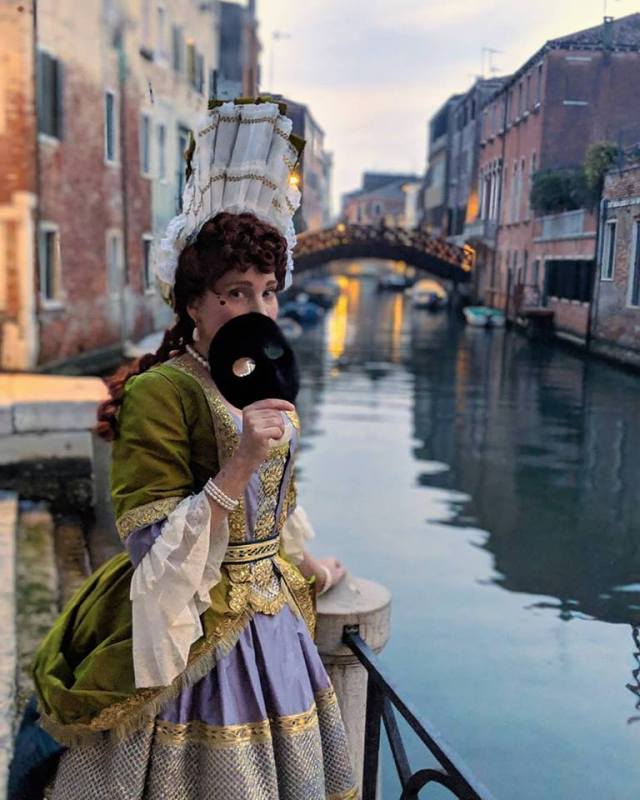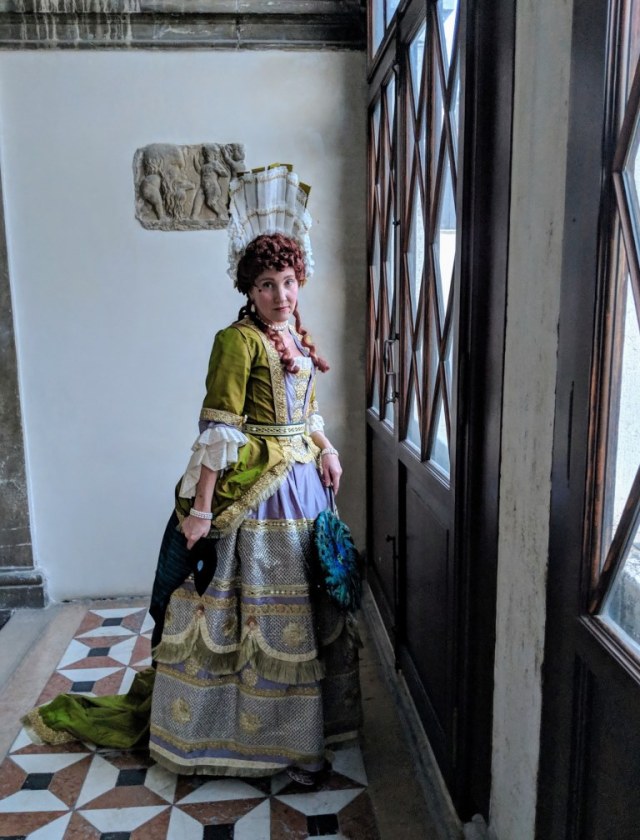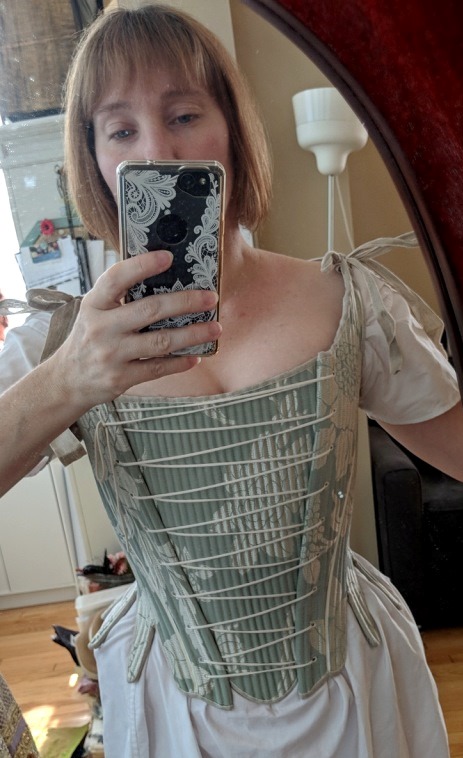For several years I’ve been very curious about late 17th century mantua gowns as the progenitors of so much of 18th century women’s fashion. I wondered how the process of making and wearing one would compare with what they later evolved into. I also wondered how they would look on a real body compared with the often-considered unattractive period images of them.
In 2018 I decided to take the plunge and try making one for myself, using Costume College 2018 as my excuse to finally do so – and boy am I glad I did because I LOVE this ensemble!
I’ve got a lot to talk about with this costume so I’ve decided to break down my 1690s mantua into a 4-part series: Foundations, the Petticoat, the Gown, the Wig, Fontange and Jewellery.
For reference and to hopefully whet your appetite for what’s to come, here are a few shots of the finished look from when I wore it earlier this year in Venice:
I had SO much fun making this whole ensemble, even though it sometimes felt like it would never end, lol!
I was pretty nervous about it at the beginning since this was a totally new period for me.
Part of the nervousness was because a new period meant new stays (duh, duh, duhhhh); my 1780s ones were just not gonna be close enough for me to cheat with them. This was the only new foundation piece I made for this costume – but I think it was enough! Lol
Here are the finished stays on me, so you can get some sense of how they create the right silhouette.
For the pattern I used sort of a mash-up of two from Norah Waugh’s Corsets and Crinolines. In the main, I used the late 17th century draft but altered it to have a stomacher front as per the 1740s stays.


The reason for the mash-up is that over the past year or two I’ve become a complete front closure convert! As much as possible I make everything with front closures, be they stays or outer garment bodices. It just makes life so much easier!
The outer layer is cut from a remnant of a silk and linen blend damask. The strength layers are heavy linen canvas, boned with reed. The lining is a medium weight white linen and the binding is linen tape.
The boning channels are machine-sewn, the remainder of construction was hand-sewn.
I recalled seeing a couple examples of extant stomacher-fronted stays so thought that would be a historically credible way to do mine.

Salmon pink stays, 1660-1680 at V&A.

Unfortunately, I have no attribution for these yellow ones. Does anyone recognize them? I am a bit thrown by them not being spiral laced but they otherwise look genuine.
Dear reader, I have since regretted this decision. I wish now that I had simply done straightforwardly front and back lacing stays without the stomacher.
They work and look fine enough but they are a PITA to lace up and having two boned layers overlap each other decidedly adds bulk! Oh well. Lesson learned.
The rest of the foundations (mainly skirt supports) were pieces already on hand, made for other periods and assembled to create my desired silhouette.
As such, the individual pieces are not Historically Accurate to the late 17th century but together they create the correct silhouette and I think they’re all plausibly at least close to pieces from the period – for which we have next to no extants.
Here are all the foundation layers I put under the outer petticoat and gown:
1.Shift and Stays
(I really need to get around to performing some surgery on my dressform’s bust so it can work better with stays and corsets!)
2. False Rump
I added this because so many prints from around the turn of the 18th century show mantuas with greater volume at the back of the skirts than can be achieved by draping up the train alone. I think there must have been some kind of additional support under there.


3. Heavy underpetticoat
This serves the dual purpose of adding volume, and warmth in cold weather. I’m sure such garments existed in the late 17th century, especially in countries that experienced real winter. Mine is cotton mattlesse, which wasn’t an available fabric at the time, but there were surely heavy wool petticoats around and/or quilted petticoats.
4. Linen Underpetticoat
This one probably isn’t entirely necessary with this ensemble but I was going with a “more plausible volume underneath is better” mentality.
5. Ruffled Underpetticoat
While my petticoat is more directly based on early-mid 19th century modes, this concept seems to have some period documentation:

It is *possible* the above image shows a decorative outer petticoat but I haven’t seen one quite like it in any fashion plates/prints from the period. And the nature of those ruffles actually look more functional than decorative to me. Anyone have any further knowledge/insight?
Next up will be the decorated petticoat!













This is stunning. The ensemble would look fabulous anywhere, but the Venice setting really sets it off. Looking forward to reading the other posts.
LikeLike
Thank you!
LikeLike
The yellow stays are from the Met:
https://www.metmuseum.org/art/collection/search/82436?&searchField=All&sortBy=Relevance&what=Corsets&ft=*&offset=0&rpp=20&pos=2
LikeLike
Thanks so much! I’ll update the post soon!
LikeLike
Congratulations on a job well done.
Marion and Marilyn
LikeLike
Thank you!
LikeLike
Dear Modern Mantua Maker — Are you still living in Washington D.C.? If so, I’d like to meet you — I am so charmed by your blog and so interested in your academic background and skills. You can find out a little bout me from my blog, The Directrice. If you’d like to meet, leave a comment for me there. Regards, The Directrice Herself
LikeLike
Hello and welcome! Thank you so much for the kind words! I’m actually not in DC anymore, I moved back to Canada back in August.
LikeLike
Pingback: 1690s Mantua – Part 2: Embellished Petticoat | The Modern Mantua-Maker
Hi! I so enjoy your work! Thank you for sharing in such a detailed manner so people like me that are just starting out can review your work and get so many questions answered. I love the detail in pictures especially. I am a visual learner! I was wondering if your ruffled petticoat is made of cotton or linen? Thank you again for sharing your work!!!
LikeLike